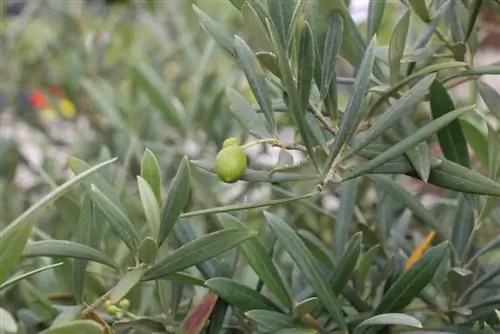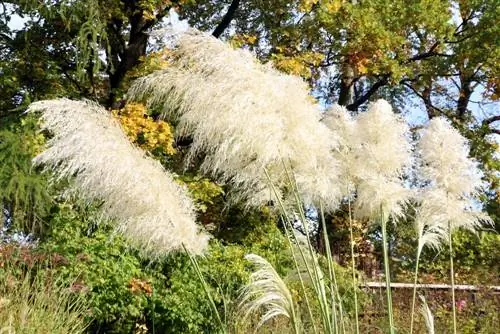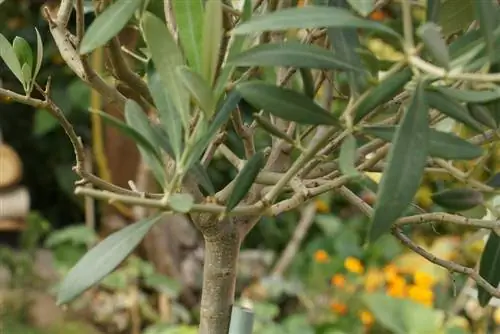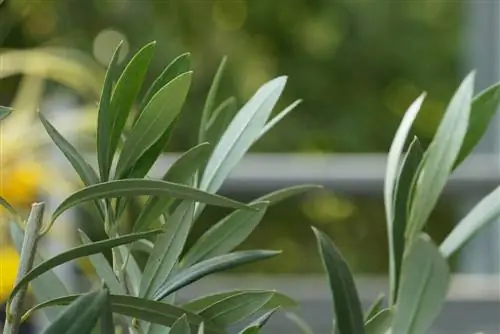- Author admin [email protected].
- Public 2023-12-17 03:39.
- Last modified 2025-06-01 06:48.
All winterization precautions are in vain if an olive tree has to endure severe frost of below -10 degrees Celsius. There are primarily three types of frost damage that an unexpectedly severe winter can cause to the Mediterranean fruit tree. Depending on whether the roots, trunk and branches or the cambium are affected, you can save the noble tree with targeted measures. This green guide will tell you step by step what to do when an Olea europaea stops sprouting.
Wintering in the garden - a climatic tightrope walk
Olive trees only thrive and fruit where the temperatures approach freezing point in winter, at least for a short time. In tropical countries with a permanently hot and humid and humid climate, you will therefore look in vain for olive plantations. In its habitats around the Mediterranean, a real olive tree can tolerate frost of up to -10 degrees Celsius in the dry winter climate. This requirement only applies to a limited extent for overwintering in the German garden. North of the Alps, winters are characterized by long-lasting cold and plenty of moisture.
In addition, there are repeated changes between freezing and thawing weather, which brings the Mediterranean Olea europaea to the edge of its resilience. Under these influences, frost damage is not uncommon even within winter hardiness zone Z8, which actually allows overwintering in the open air. Young olive trees are particularly affected, as frost tolerance only gradually builds up to a temperature minimum of -10 degrees Celsius.
Three types of frost damage
Olive gardeners and botanists differentiate between the following 3 types of frost damage, which can be remedied with adequate measures:
- Frost damage to the cambium
- Frost cracks on the trunk and branches
- Frostbite in the root area
The extent of this cold damage depends on various criteria, such as the local light and temperature conditions or the olive variety. Anchoring frost damage solely at the temperature minimum is therefore not enough. Other factors must be taken into account, such as the specific temperature profile, the temperature spread between plus and minus degrees or the actual duration of the frosty weather. The soil quality, local lighting conditions and the constitution of the olive also play an important role. Below we will explain in detail how you can identify the actual frost damage and motivate your real olive tree to sprout again.
Frost damage to the cambium
The destruction of the cambium by frost is the biggest problem for olive trees in the garden. This applies equally to olives in the bucket and in the bed. The growth layer between the outer bark and the physiologically active sapwood or xylem is called the cambium. The pathways for water and nutrients are located in this area. The cambium therefore primarily has an important protective function. At the same time, it contributes to the growth in thickness of the trunk and shoots.
If your olive tree lets its leaves droop after a bitterly cold winter night or, in the worst case, drops them, a frozen cambium can be identified by two features. The bark above it can no longer be easily peeled off because the frost has disrupted the metabolism to such an extent that it is stuck to the cambium.
If you scrape off a little of the bark, the first layer underneath will be dark brown to black. Unfortunately, the bark can still appear undamaged at this point because, as a chlorophyll-bearing layer, it only gradually develops an unhe althy, brown discoloration. If you suspect something, be sure to take a look at the cambium underneath. Use this action plan to solve the problem:
- Wait until mid/end of June to prune so that the new growth can be clearly seen
- Conduct a vitality test on all leafless branches by scraping off the bark in places
- Where green tissue can no longer be seen, a shoot has died
- Use sharp, clean scissors to shorten the branch down to he althy, green wood
- Tighten out completely dead branches on Astring
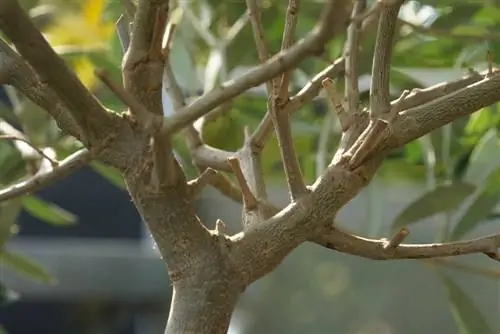
If an olive tree with frost damage is radically cut back to the he althy wood, it reacts differently than after a regular shape and maintenance pruning. As a rule, two opposing branches sprout below an interface. Not so with a frost-damaged specimen. Here the new growth shifts to the regions near the ground. This behavior enables the crown to be rebuilt, as was already achieved once with a training cut on a young olive tree.
Tip:
After extensive pruning due to frost damage, give the stressed olive tree a helping hand with careful care. Nitrogen-based fertilization and watering as needed in a sunny, warm location will get growth going again.
Frost cracks on trunk and branches
Frost cracks usually appear in late winter. At this time, temperatures still fall below freezing at night, while the intensity of the sun's rays increases during the day. As a result, the temperature fluctuations put the bark under tension. If this stress becomes excessive, the bark tears lengthwise. Where this frost damage occurs, immediate action is required. If water gets in through the cracks and freezes, your olive tree will hardly recover. Diseases and pests use these wounds as a welcome target. This is how you proceed professionally:
- Wrap cracks less than 5 cm long with water-repellent, breathable fleece or straw tape
- Treat larger cracks in the bark promptly with a wound closure agent, such as Malusan wound closure from Neudorff
- Put the preparation on the edge up to a maximum of 5 cm into the wound
- Do not tear off loose pieces of bark, but attach them back to the trunk with small nails
The use of wound closure agents is controversial among experts. The fact is that there is currently a lack of scientific evidence that these products prevent the tree from being colonized by wood-destroying pathogens and pests. However, the application is not useless after a frost crack.
Wound closure agents have an effective protective function on the vital cambium. In this way, they give the tree enough time to overcome the wound. This is particularly true for frost damage, as this occurs at a time when your olive tree is still dormant. Based on this knowledge, we recommend that you do not apply the agent to a crack in the bark over the entire surface, but rather only along the edges of the wound.
Tip:
Frost cracks on trees are also known as the 'Labello effect'. Dryness doesn't just cause lips to crack when exposed to cold and sunlight. By watering your evergreen olive tree every now and then, even in winter, you can effectively prevent frost cracks.
Frostbite on the roots
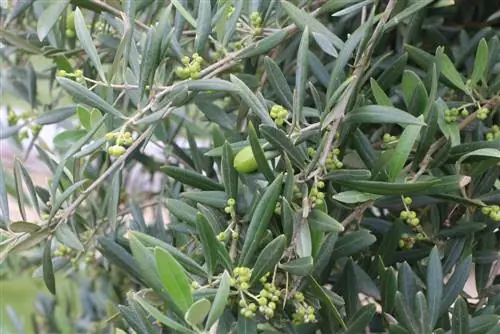
An olive tree in a bucket is primarily affected by frost damage in the root area. In its exposed position behind the container walls, a root ball is much more vulnerable to cold than in the shelter of the garden soil. In contrast to damage to the cambium or bark, frostbite on the roots only becomes apparent after the growth and flowering period has begun. Loss of leaves and wilting flowers signal that the supply via the roots is impaired. It is alarming if you can lift the olive tree out of the substrate with just a slight pull. How to act correctly:
- Unpot the ball with the frost-damaged roots
- Shake off the substrate completely to get a clear view of the root system
- Cut out dead, brown, rotten root strands
- Pot the olive tree in fresh substrate and water it
Depending on the extent of the root pruning, it may be necessary to shorten the shoots proportionally. If half of the root volume is lost, cutting back the branches by around 30 percent will restore the balance. Reducing the root ball by a third or less can help your olive tree regulate itself in the middle of the growing season. The administration of a plant fertilizer for Mediterranean trees has a beneficial effect on regeneration.
Conclusion
In the cold, wet Central European winter, an olive tree in the garden can suffer significant damage even at temperatures around freezing point. If the mercury column falls well below the temperature minimum of -10 degrees Celsius, hardly any Olea europaea is spared. Frost damage occurs primarily on the cambium, trunk and branches, and in the root area. In order for the Mediterranean ornamental and fruit trees to sprout again, the package of measures should be based on the actual damaged area. A frost-damaged cambium requires radical pruning back to he althy wood in early summer. However, frost cracks must be treated immediately to contain the damage. Special closure materials are recommended for larger wounds, while a water-repellent, breathable bandage is sufficient for smaller tears. If an olive tree in a pot suffers frostbite on the roots, the damage is repaired by root pruning, combined with repotting in fresh substrate.

